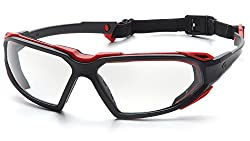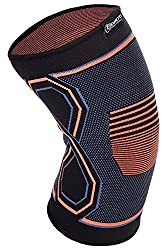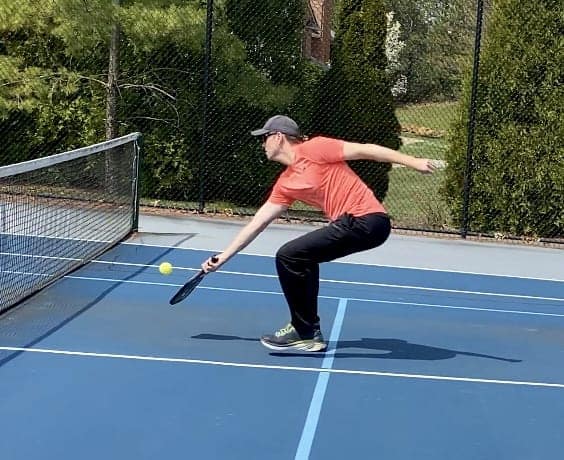Common Pickleball Injuries and How to Avoid Them
Pickleball injuries are becoming more and more common as the game continues to grow in popularity. Pickleball has exploded because of how easy and fun it is…especially with older, retired folks looking to stay active.
However, many senior players are at a greater risk to experience a pickleball injury of some kind. If you are new to the game or a novice player, it is crucial that you set yourself up for success and keep yourself out of harms way.
This post is designed to give you all the information you need around common pickleball injuries and how to avoid them. We’ve even sprinkled in some of our own experiences and talk about what it took to get back on the court after suffering an injury.
Remember, bumps and bruises are going to be a part of the game but avoiding a serious debilitating injury or even a game ending injury is paramount.
RELATED: Want to know what 4 pickleball insiders taught me about pickleball paddles? I learned 17 never before talked about facts about paddles that blew my mind!
Common Pickleball Injuries
The most common pickleball injuries are ankle strain (stretch or slight tear of a ligament), achilles tendon strain (stop and go, or change of direction), heel strain (overuse injury), knee sprain (often sprain of medial collateral ligament), hamstring strain (overextending, reaching for a ball), wrist fracture (falling backward and landing on extended arm), and shoulder strain (overuse and swinging too hard on overhead shots).
But, don’t let this scare you. Pickleball has many real-life health benefits too! I wrote all about how pickleball can improve your health in this post here.
However, injuries can happen so the best defense against them is to be prepared for them.
My Number One Pickleball Injuriy Rule – Proper Foot Wear
Arguably the most common pickleball injuries experienced in the knee or ankle area can have been prevented by wearing proper shoes.
Many people new to the game will step onto the court without even thinking about what type of shoes they’re wearing. They’ll grab whatever pair of athletic shoes they’ve got handy, and begin playing.
We could make a case that the single most important piece of equipment you buy when first starting out, is NOT a paddle – but is in fact YOUR SHOES!
Court shoes that allow you to move and shuffle around the court without too much trouble are ideal. You must be able to move forward and backpedal without your shoe catching on the floor.
We have been told and learned first hand (the hard way) that running shoes are the WORST type of shoe for pickleball. They have a tendency to grab and stick to the court at the worst time. This can lead to torn or pulled muscles from the foot, ankle, calf, knee, leg, back, or neck.
Court shoes allow for the proper amount of give. The soles are more flat and smooth. They do not have deep treads like running shoes. The treads on court shoes are much smaller and closer together which allow them to slide. Get the picture?
The correct shoes are a must. A good pair of court shoes will help prevent serious injury. This is by far the easiest way to avoid the most common of pickleball injuries.
Court shoes are just what they imply–shoes to wear when a playing on a court floor of any kind. The bottom of the shoe needs to be able to give or slide on the court when reaching for a shot.
If wearing a running shoe, that shoe will not allow the foot to slide and will stop abruptly. The “give” will be transferred to the muscles which often results in injury.
My worst injury came from tearing a calf muscle while backpedaling quickly to make a play on the ball after a lob shot.
A good friend also tore his achilles heel while playing pickleball in running shoes. This is a serious sports related injury! He is still recovering, and is done with pickleball! Pickleball in running shoes is a recipe for disaster!
“The correct shoes are a must. A good pair of court shoes will help prevent serious injury. This is, by far the easiest way to avoid the most common of pickleball injuries.”
Loose fitting pants that bag around the ankles is a recipe for tripping, and falling. Court shoes can get hung up in the extra material around the bottom – causing tripping, falling and racking up all kinds of muscle strains. Be sure to wear shorts, or some kind of fitted pants.
We realize these suggestions are relatively routine and self explanatory. However, you’d be surprised at how many beginner players make these mistakes, end up injuring themselves, and consequently never play again.
Pickleball Injuries – Protective Eye Gear

It is also important to wear goggles or protective eye-wear. Many of us have hit ourselves with the paddle, or had a ball ricochet off the paddle and hit the eye, or near the eye. It has happened to me, and it may happen to you.
Again, common sense is a good guide, and most doctors recommend wearing protective eye-wear while playing pickleball.
Pickleball Injuries – Conditioning
Core strength, and warm up exercises go hand in hand. Yoga plank poses, push ups, squats (hover over a chair – then stand up), stretches, and balance exercises (like stand on one foot) are good conditioning drills for pickleball.
Another best practice is to breathe with your diaphragm while doing all of your prep work.
Keep in mind your power comes from your legs and body rotation.
Some good advice is to learn how to fall and roll properly, and not extend your arm to catch yourself. You could potentially fracture your wrist or arm while trying to break your fall.
A good exercise is to lay on your back, and practice rolling over and getting up to a standing position.
Good players bend at their knees (like a squat position) and coil and uncoil their upper body. Unfortunately, many players bend from their waist, and use their arms to hit the ball. Good balance is also important, and helps you get ready for that second and third shot.
Pickleball can help you increase your overall sense of well-being (leave in a good mood), if you play hard, but within your physical limits, rest, and stay hydrated. I learned this the hard way too, and had to stop playing, because I got dizzy and felt light headed. Now I always have a water bottle and snack bar with me every time I play.
Pickleball Injuries – The Recovery Process
If you’ve experienced a pickleball injury then you know recovering and returning from injury is part of the game. It’s always good to remember R.I.C.E. (Rest, Ice, Compression, Elevation).
See your doctor if you need to. Follow a good rehab protocol, and get back to playing and enjoying pickleball. It is good for the body, and good for the soul but you must know when to put the paddle down for dedicated recovery time.

Depending on the severity of the injury you may be off the court for a few days, weeks, or months. It has been my experience that it is best to ease back into your pickleball pace, and routine.I warm up, and walk, and stretch more before playing. I also sit out and rest a little bit more during the first few weeks back, after an injury. Know your limits, wear your braces, and keep your medicines close at hand.

Products to Consider to Prevent Pickleball Injuries
As we’ve said before, the most important piece of pickleball equipment to prevent injury is your shoes. In addition, a good knee brace or compression sleeve is a good idea if you’ve had knee injuries in the past. The same can be said for ankle support so we’ll include an ankle support sleeve as well.
Last but not least is a good stretch brand. Stretching before you play is vitally important so your muscles and tendons are warm, loose and ready. Showing up, getting on the court and playing immediately without stretching is a bad idea.
Investing in a good stretching band, to use either at home before you play or at the courts while warming up, can prevent common pickleball injuries like a pulled muscle.
Products to Consider to Heal Faster From a Pickleball Injury
To help get you back on the court faster we’ll talk about a few products that can help speed up the recovery time of common injuries like a sore back or calf.
Obviously, it’s best to consult with your physician before taking any medication. For back pain, a good back brace like a Mueller Back Brace can help tremendously.
We recommend this one because we’ve used it, and you actually wear it and play at the same time. It’s that comfortable! In addition, a good heating pad or heated message pillow while resting at home can help your back loosen up. I’ve had two back surgeries so when my back locks up, getting heat to my lower back is crucial.
That’s why we’re also big fans of a TENS unit electric pulse massager. This product has been so helpful for me! It’s versatile because you can use it on your back, knee, shoulder, elbow…you name it!
It’s helped my lower back by sending electric pulse signals through the nodules giving my back a warm massage feeling that loosens it up. I highly recommend this product, it’s helped me a lot!
Lastly, a good cramping ointment isn’t a bad idea to have on hand at the court in case you feel a leg cramp coming on.
The 3 Fundamentals to Avoiding Pickleball Injuries
Pickleball is played by a lot of people – young, old and everywhere in between. Consequently, to avoid injury, we all need to prep our bodies before we play. Of course stretching the muscles before playing is critical. Being in relatively good shape is also important.
- PROPER ATTIRE: Wearing the proper attire is very important, especially when it comes to shoes. NEVER wear running shoes. Court shoes designed for indoor pickleball play are BEST!
- WARM UP: The older you get, the more important it is to stretch everyday. This becomes especially important before any physical activity. Remember, playing tight before muscles have had a chance to warm up, could lead to a short day on the court – and a long day in pain. We like to slowly and gently stretch our leg muscles, our back, and make sure our shoulders are loose. We also recommend bouncing the ball up and down on your paddle.
- LISTEN TO YOUR BODY: Playing within your physical limits is a smart choice. If you don’t have the flexibility to be shuffling back and forth and all over the court like a mad man, then don’t do it. Our minds often think we can do the things we used to do when in our 20s but our body responds differently. Listen to your body in those instances, not your mind.
Finally, many pickleball injuries can be avoided by using common sense, and remembering why you play pickleball. It is fun, good exercise, and can relieve stress.
If you’re new to the wonderful sport of pickleball, check out our How to Play Pickleball Guide!
We’d love to hear from you if you thought this article was helpful. Please, leave a comment below and let us know what you’d like help with or what you’d like to read more of!

Welcome to TheVolleyLlama.com. My name is Keith, I’m just a lover of all sports that involve a racquet, net and a ball. I played competitive high school varsity tennis, love racquetball and my whole family plays pickleball regularly. I started this website to help give people like you the basics to learn these wonderful games.

